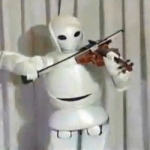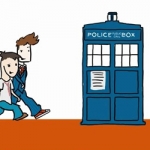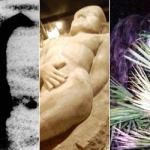In the last Geek’s Guide installment, we looked at robots who make music — machines programmed to mechanically make sounds on regular acoustic instruments. This time, we turn the tables and look at the history of humans making music through electronic means. Since Robert Moog created the first modern synthesizer in the mid-1960s, and with the advent of MIDI technology, electronic music has become so commonplace that we don’t even notice it anymore. Prior to the ’60s, however, creative composers and inventors made great strides with this modern form of music-making. Even a brief survey of the history of electronic music would require more pages than blog readers want to see at one time, so instead I am going to hit the highlights — a famous pre-synthesizer instrument, some famous composers of electronic music, and a well-known sci-fi application of electronic music.
Beginnings
One of the first electronic instruments was the Theremin, created around 1920 by (and named after) Russian inventor Leon Theremin (1896-1993). The picture at the top of the article shows Theremin playing the instrument, which was originally named the etherophone. It consists of a box full of electronics and two external antennae. The player moves his or her hands nearer to or farther from the antennae to change the sounds produced by the instrument — one hand controls the pitch of the sound, and the other controls the volume. A better explanation, as well as an excellent sampling of music played on the Theremin, can be found in Theremin virtuoso Pamelia Kurstin’s 2002 TEDTalk. It is twenty minutes long, so if you don’t have that much time to spare, she plays for the first five minutes or so, then she gives a basic explanation/demonstration.
One of the amazing things about the Theremin is its longevity and its use in a variety of settings. It is most familiar as the 1950s B-movie science fiction sound effect — listen for it in this trailer for the 1951 film, The Day the Earth Stood Still:
Pop musicians liked it, too, most notably the Beach Boys, who included it in their hit song, “Good Vibrations”:
If you want a really in-depth look at the Theremin and its inventor, look for the documentary called Theremin.
Classical Electronics
While most classical composers throughout the 20th century still wrote music for traditional acoustic instruments, some began experimenting with electronic means of making sound. One of the more well-known of these was French composer Edgard Varese (1883-1965), who first began experimenting with electronic music in the late 1920s. One of his most famous works was Poeme Electronique, a piece of music written for the Philips Pavilion at the 1958 World Exhibition in Brussels, Belgium. The pavilion was sponsored by the Philips company to showcase its audio and video technology by means of a multimedia presentation of Varese’s music paired with various video images. Here it is — feel free to get an idea by liberal use of the slider to skip ahead if this kind of music is not your cup of tea.
Another well-known American composer of electronic music was Milton Babbitt (1916-2011), who experimented with minimalist and serial composition techniques in addition to using electronic forms of music-making. He also experimented with combinations of traditional and electronic sounds, as here in his 1964 composition entitled Philomel, written to be performed by a live singer with recorded synthesizer accompaniment and a recorded singer’s voice. This was one of the sample compositions in my college music history text, so I have many fond memories (yeah, right) of listening to it while preparing for listening tests…
Electronics in Science Fiction Television
I have recently discovered one of the greatest producers of electronic music ever: the BBC Radiophonic Workshop, which provided background music for a variety of BBC television programmes in the second half of the 20th century, the most notable of which was classic series Doctor Who. The workshop was started in 1958, and the methods of producing their tracks was extremely laborious and time-consuming. They used either electronic devices or everyday objects to produce sounds that were recorded onto magnetic tape. They could then use other electronic devices to manipulate the sounds, which were recorded onto other tapes where they could be played along with other tapes to create a complete score. No synthesizers here, folks! If you are interested in an in-depth look at what they did, look for Alchemists of Sound, a documentary about the workshop (it’s on YouTube). Also on YouTube is Sculptress of Sound, which is about Delia Derbyshire, the woman who is responsible for taking Ron Grainer’s outline and turning it into one of the most famous theme tunes in sci-fi television:
Another fun fact: the TARDIS appearing/disappearing sound effect that was created by the Radiophonic Workshop in the 1960s is one of several original sound effects that is still being used today in the new series episodes of Doctor Who.
I hope you have enjoyed this smorgasbord of musical information — it really only scratches the surface of this huge topic. If you have specific questions about electronic music — either what I mentioned here or something I was not able to cover — please feel free to visit during office hours (any time, via the article comments) and I will do my best to give you an answer or direct you to more information. Thanks, class! See you next time, when you should come prepared to discuss… well, something to be announced later.







